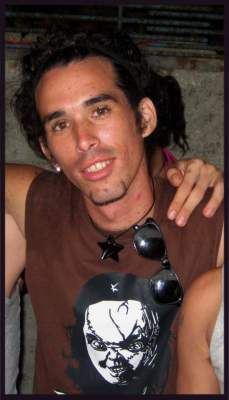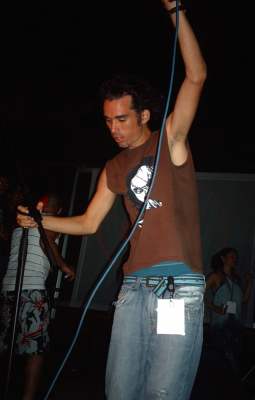The Creative Madness of “Jorgito”
Interview by Osmel Almaguer

HAVANA TIMES, June 29 — A mid-level technician by trade, since the seventh grade Jorge Lian Garcia Diaz, 25, has founded musical groups with his buddies from his Havana neighborhood of Cerro. The first one they named “Sentencia.” He performed with that group in the Primer Festival del Cerro and in the Piscina Gigante de Alamar. He then auditioned for a band called “K-faith Habano” and was accepted as a rapper.
– See article on the Kamonkola Project.
Later on he worked as a roadie for the group “Aceituna sin Hueso” and succeeded in seeing his rap work accepted; he was able to secure a chance to perform each appearance of the group.
Thanks to their lead singer and director, Miriela Moreno, he sang in prestigious venues across the country, places like the Garcia Lorca Theater and the Havana Fine Arts Center, among others. Then, with Yibran Rivero and Vicente Alejandro, both guitarists with Aceituna sin Hueso, he recorded his first demo named Musas Desechables. From this demo came the “Kamankola” project.
HT: What does the Kamankola project consist of?
Jorge Lian Garcia Diaz: In the first place, I should say that “Kamankola” is a word from Cuban slang that means intrigue or schemes. Kamankola is made up of all my creative madness. Everything begins with the words, and then I begin to fill my head with all the music I want to back up the lyrics.
The music can be anything from the blues to a rumba, that’s to say I don’t have musical barriers in that sense. The principal objective of Kamankola is to invade the subconscious of whoever listens to it, with the goal being to achieve reflection. But on the other hand it’s also to enjoy my music, to feel each strike of the conga, each clave, each drop of sweat.
HT: When and how did the group emerge?
JLGD: It emerged, as I just said, with the creation of the demo. When I had the disk in my hands with its 10 songs and I understood that it contained everything I stood for, that touched my heart; it fed my spirit. I understood that I really needed to take it out into the streets.
We begin with the help of “borrowed musicians,” with the bassist from “Doble Filo,” the guitarists from “Aceituna sin Hueso,” and a drummer who was in fact a kettledrummer and a monster conga player who came with me from “K-faith Habano.” Me — as the composer, director and singer of the group — I fought hard through all this, but I didn’t imagine it would be so hard to get it going and move ahead.
HT: What other musicians have also collaborated with Kamankola?
JLGD: I belong to the Hermanos Saiz Association, and thanks to it I had my first concert in the Madriguera. The truth is that I’ve been lucky in the sense of collaboration. I struck up some sincere and solid friendships with some musicians who still today haven’t stopped saving my butt. That’s the case of Yamil-flow, a singer and the director of the “Deja-vu project.” Every time I have a craving to do something he’s there to help without any type of self-interests. Then too there’s the case of Vicente and Yibran (now the duo “DcoraSon”) who also take time out to work with the band, as is also the case with Dario, the director of the video project “Bajo Costo Visión,” and so on. There are a lot of folks.

JLGD: Obstacles? Lots! I believe that here if you can’t perform magic you remain stuck along the road. Here there’s no way to solve anything. You have to jerry-rig things together the best you can, and if you aren’t able to – you’re screwed. Me, like so many artists, I’m up to my neck in dreams.
There are times when I feel it’s impossible, but it’s necessary to be strong, to pull out the stops and say to yourself that you have to keep going. If you don’t think like this you’ll find yourself beat down by the first obstacle they put in your way. You’ll never do anything or complete anything. The struggle is long and victory is an enigma, plus the obstacles are increasingly bigger. The only thing that can’t stay tiny is your heart.
HT: And in terms of the songs, what to you want to communicate in your music?
JLGD: I have two types of songs: those that speak to the heart and those that touch the soul. In the first ones I play songs that are completely real. I critique everything that bothers me, everything that traps me and suffocates me, everything that’s oppressive. In terms of the other I let the muse make love to me. From there anything can come. It’s letting yourself being taken by the wind to wherever it wants to take you. It’s enjoying the art of composing, of knowing that you have things to say.
HT: Have you received any type of recognition that gives you the energy to continue?
JLGD: Thanks to my sole demo, I wound up getting nominated at the Cuerda Viva Festival in the “fusion” category. I’ve also made several performances of it. I was nominated and awarded at the Puños Arriba Festival in the category of “best spoken word song.” Right now I’m recording a second demo, and this time I’m seeking the same thing as with the other one: to touch people’s heart.
Unfortunately money is everything in this materialized world. And of course for me I’ve had to play even more subordinate roles. Without money you can’t do anything. I have to maintain a band, and that implies having instruments and those types of things. To perform anywhere it’s necessary to transport all those instruments, and for that you need money. To rehearse you need audio equipment, and to rent that equipment it takes money. To record a song (which is not my case, fortunately) you need a studio, and to get studio time you need money. For everything, with all the twists and turns you have to go through, you need some damn money.
HT: Which are the nutritional fountains from which Kamankola drinks?
JLGD: As musical preferences go, like the old saying goes, my tastes run from the sublime to the ridiculous. I consider myself more of a Los Van Van fanatic, but I also follow the music of Interactivo, the madness of Francis del Rio, the sentimental songs of Polito Ibañez, those of Pancho Cespedes, Joaquin Savin’s metaphors, Alejandro Sanz’s poetry, etc. These are my sources of consumption. From here come all my songs, from all of these greats of music and song.
HT: How much presence do young musicians have in the social panorama of Cuba today?
JLGD: The youth are coming on strong, with lots of maturity, with a lot of conviction around what they want. I believe that it’s necessary to give them space, real space, not just saying that it exists when it really doesn’t.
HT: You have acknowledged feeling proud of being Cuban. What does Cuba mean to you?
JLGD: Cuba is everything; it’s the foundation, feeling, pride. To be Cuban is to be history, it’s to look behind and ask: “What was Cuba? What is Cuba? What will it be?” There are those who struggles for what was, those who struggles for what is, and I struggle for what it will be. And I want it to be like many others have wanted to be – free!





